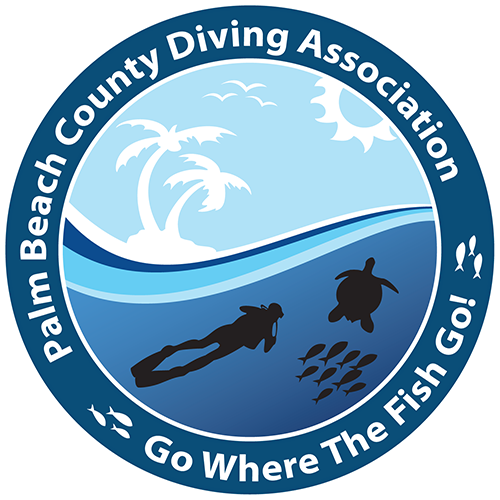28 Jul / Introduction to Palm Beach Coast Reefs

The bottom topography along the Palm Beach coast is quite different from most places in the Caribbean or the Florida Keys.
Instead of spur and groove formations built from living corals, Palm Beach reefs are comprised of ancient limestone. Varying in height from 3 to as much as 18 feet above the sand they are far from featureless. Remnants of ancient coral reefs from an earlier millennia when sea levels were 30 to 140 feet lower than they are today, these elongated limestone escarpments vary in width, but are typically around 300 feet wide from east to west, and can run for miles north to south.
Along the southern half of the Palm Beach County coast, the more dramatic formations start just north of the Boca Inlet, where a single ridge line parallels the shore in depths between 60 and 110 feet nearly all the way up to the Lake Worth Inlet.
One of the longer collections of ledges in this region is the Delray Reef System, which stretches distances of 4 to 5 miles at a stretch before terminating in the sand completely for short intervals, then re-emerging again on its north bound heading. Down its center, depths can reach to within 45 feet from the surface and typically feature highly pronounced ledge formations 5 to 15 foot high with deep undercuts facing the west towards shore. Down the eastern side towards the open sea, bottom contours are less dramatic, dropping more gradually to depths of 90 to 110 feet.
Far from lifeless, this limestone bedrock is host to a broad range of benthic inhabitants. While there are a few varieties of stony corals, there are rich carpets of colonial sponges, gorgonians, and hydra-corals. The most colorful are the orange elephant ear sponges, the deeper-hued orange and red tree sponges, and even more eye-popping red polyp octocorals.
As beautiful and dramatic as the shelf can be, the greater appeal is the abundance of marine life, which aggregates along the structures and finds shelter in the numerous crevices and undercuts. Often times large schools of grunts, porkfish and snappers can be seen either milling out front or sitting beneath the reef’s protective overhangs. Overhead, divers will frequently encounter large progressions of spadefish and jack crevalle. Sometimes larger varieties like amberjacks, eagle rays or reef sharks will make their appearance, either following the fish schools or looking as if they are escorting them.
In addition to fish, large loggerhead, hawksbill and green sea turtles, as well as hefty size nurse sharks, favor the ledges as a quiet, protective spot to catch a few zzz’s away from predators, wave surge or current. Closer inspections of the underside of the ledges and/or gaps in the top will reveal several varieties of small tropicals, moray eels and invertebrates.

cherubfish, aka pygmy angelfish (Centropyge argi) right, a black brotula (Stygnobrotula latebricola) left
Some of the more remarkable finds on these reefs can be quite small such as the diminutive orange faced, purple-blued bodied cherubfish, aka pygmy angelfish (Centropyge argi) which can be mistaken for a damsel fish because of their hyperactive behavior. Even stranger is the black brotula (Stygnobrotula latebricola) a deep brown to pitch black fish with a semi eel-like body that can be found hovering inside the reef’s deeper cracks and holes.
Along the upper half of the Palm Beach County coast, the topography of the reef changes just south of the Lake Worth Inlet. In place of one primary ridge line, the limestone bedrock sets off in a series of ridge formations running parallel to one another, with the westernmost formation rising more than 30 feet off the bottom to create an elongated escarpment called North Doubles and South Doubles. As their name implies, instead of one there are two principal west-facing ledges running parallel at two different depths, with a combined relief of 30 feet. The lower ledge meets the sand floor around 90 feet, and some 50 to 100 feet to the east; the second ledge then rises to within 60 feet of the surface before beginning a gradual slope back into the depths.
Moving northward beyond North and South Doubles, the sea floor becomes increasingly convoluted, forming a complex labyrinth of bottom contours of varying heights riddled with deep undercuts. Many of these formations lie in depths of 60 to 90 feet.
The largest and most extensive of these formations is the Juno High Bar, a massive escarpment that commences off Juno Beach and stretches northward to a point even with the Jupiter Inlet. Like the formations to the south, the Juno Bar’s highest formations face west, and run northward for approximately 8 miles with only one minor break.

A trio of large 350 to 400 lb. goliath grouper milling in the shadow of the Juno Bar ledge provide scale to the height of the reef’s west facing ledge.
As compared to ledges to the south, coral and sponge growth may be sparser at time. But what it may lack in the color department, the Juno High Bar makes up for in the dramatic. This is the region the locals call the land of the giants. In part for the tallest ledge formations off the coast, some rising 18 feet straight off the sand bottom, with undercuts large enough for divers to pass through. But the main reason for this title is the marine life, which seems to take on even larger presence, with giant loggerhead turtles and goliath groupers as the main attractions, and both giant leatherback turtles and sharks adding to the cast between fall and spring.
In addition to the wealth of reefs and marine life, the Palm Beach County coast is not without a plenitude of wrecks to dive. To learn more about them visit the Wrecks page.


